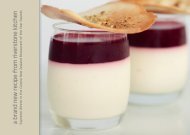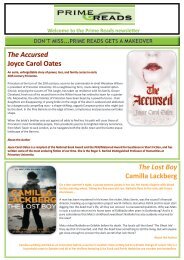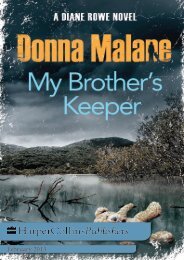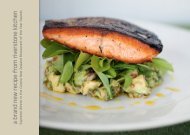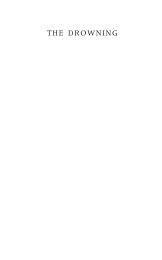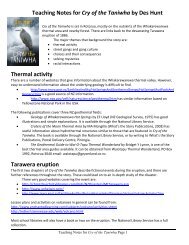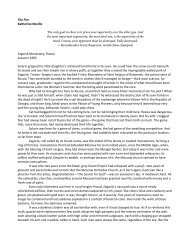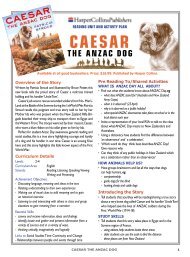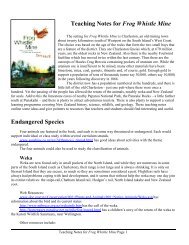The Carpet Of Dreams - Harper Collins New Zealand
The Carpet Of Dreams - Harper Collins New Zealand
The Carpet Of Dreams - Harper Collins New Zealand
Create successful ePaper yourself
Turn your PDF publications into a flip-book with our unique Google optimized e-Paper software.
<strong>Carpet</strong> of <strong>Dreams</strong><br />
Written by Tessa Duder and illustrated by Mark Wilson<br />
Teaching notes written by Christine Sarandis<br />
Book Description<br />
When Sara goes to stay with her grandmother, she discovers a dusty old Turkish carpet in the attic. Mesmerized<br />
by beautiful animals woven into the carpet, she embarks upon a magical and dreamlike journey that takes her<br />
back through time and place, to ultimately discover the roots of her family.<br />
An exquisitely illustrated picture book that celebrates the importance of family and cultural history and the special<br />
bonds between grandparent and grandchild.<br />
Author biography<br />
Tessa Duder is a leading <strong>New</strong> <strong>Zealand</strong> author for both children and adults. She has an international following for<br />
her multiple award-winning Alex and Tiggie Tompson series, and her work also includes short stories, plays,<br />
non-fiction and anthologies. Alex, the first book of the acclaimed Alex Quartet, was made into a feature movie,<br />
while among her recent books for adults is an acclaimed portrait of the 2006 Hans Christian Andersen Medal<br />
winner Margaret Mahy.<br />
A recurring theme of her work is Tessa’s love of the sea and related activities such as sailing and swimming,<br />
which she says reflects her upbringing as an Aucklander. Earlier in her life, she won a Commonwealth Games<br />
silver medal for swimming, and currently she serves on the Spirit of Adventure Trust which operates <strong>New</strong><br />
<strong>Zealand</strong>’s youth development tall ship.<br />
Among Tessa’s awards are the Storylines Margaret Mahy Medal and in 2003, <strong>New</strong> <strong>Zealand</strong>’s most prestigious<br />
literary fellowship, the Meridian Energy Katherine Mansfield Fellowship to Menton, France. She lives and works<br />
in Auckland and has four daughters and two grandchildren.<br />
For more information on Tessa, go to: http://www.tessaduder.com/<br />
1
Illustrator biography<br />
Mark Wilson is an artist who has won numerous awards for his children's book illustrations. He won a CBCA<br />
Award in 2006 for Young Murphy: A Boy's Adventure and in 2004 won the Whiteley Award and the Wilderness<br />
Society Environment Award for Children's Literature for <strong>The</strong> Extinction Trilogy. His previous book, Yellow Eye,<br />
won both awards in 2002.<br />
On his website, Mark says:<br />
I was born in Melbourne in 1949. I always loved drawing, and spent most evenings drawing on huge sheets of<br />
paper that my dad brought home from work. I then spent my teenage years pretending to be a drummer in a rock<br />
band.<br />
I Studied Mural design, painting at C.I.T. (now Monash-Caulfield Campus), and did a diploma in education the<br />
following year. In the early seventies, I became designer and illustrator for <strong>The</strong> Education Magazine and Pursuit<br />
magazine still playing drums though!). For the last seventeen years, I have been freelance illustrating children’s<br />
books, also doing history, sport, architecture and conservation books and kits.<br />
Much of my painting is involved with conservation and wildlife, particularly endangered species. My new book for<br />
Lothian, Prayer for the Animals, deals with this subject, as do many of my books with Gary Crew, like <strong>The</strong><br />
Extinction trilogy for Lothian.<br />
For more information on Mark, go to http://www.marklwilson.com.au/<br />
Characters<br />
Sara, Babaanne, other members of their family referred to in the story<br />
<strong>The</strong> story opening<br />
‣ How often did Sara stay with her grandmother?<br />
‣ Why had Sara’s grandmother planted cheery and apricot trees in her garden?<br />
‣ What was different about this recent visit and what did Sara notice for the first time?<br />
‣ Which sensations did Sara experience as she entered the room?<br />
‣ Describe the things Babaanne told Sara about the carpet?<br />
‣ Why did Sara want the carpet in her room?<br />
‣ Who had enjoyed adventures with the carpet before Sara?<br />
‣ Where might the carpet have come from?<br />
<strong>The</strong>mes and thematic study<br />
<strong>Dreams</strong><br />
Dream 1<br />
Roses<br />
‣ In Sara’s first dream she meets a girl who will lead her on her journey. Discuss who this girl might be<br />
and her role in Sara’s dreams.<br />
‣ In this dream, what was the first thing Sara noticed?<br />
‣ What did Sara learn about roses from the dream?<br />
‣ Describe the link between the rose dream and what Sara learns from Babaanne when she awakes.<br />
(Please refer to the rose jam recipe below.)<br />
‣ Try making the Rose Jam recipe listed below.<br />
Pink rose petal jam<br />
You will need:<br />
6 cups white sugar<br />
2 cups rosewater<br />
1 cup orange flower water<br />
1 cup water<br />
24 sweet scented pink roses<br />
1 cup boiling water<br />
2 tsp lemon juice<br />
Method:<br />
Combine sugar, rosewater, orange flower water and water in a non aluminum saucepan. Bring to the boil and<br />
cook rapidly until mixture is syrupy.<br />
2
Prepare roses by removing white 'heel' from petals and place in a large china bowl with the cup of boiling water.<br />
Stir gently. Add petals and liquid to boiling syrup continuing to stir constantly. Boil for a further 30 minutes,<br />
pressing petals down into syrup. When petals are tender and syrup has clarified, add lemon juice and continue<br />
to boil again until gel point is reached. Spoon into sterile glass jars and cap securely.<br />
Dream 2<br />
Buffalo<br />
‣ In this dream, Sara learnt about the buffalo or bison. What was his complaint?<br />
‣ Which activity did Sara’s discussion with Babaanne lead to in this instance?<br />
Dream 3<br />
Dolphins<br />
‣ What did Sara learn about dolphins in this dream?<br />
‣ And when she awoke, Babaane told her more about them. Which activity did Sara and her<br />
grandmother decide to do after this dream?<br />
Dream 4<br />
Lions<br />
‣ In this dream, the lion reveals the threat to his species’ existence. What is it and how has it affected<br />
his species?<br />
‣ And Later, Babaanne explained how lions live in family units as part of a pride. Discuss and<br />
compare this with other animal species’ way of life.<br />
‣ How did Babaanne and Sara plan to learn more about lions?<br />
Dream 5<br />
Peacocks<br />
‣ What did Sara learn about the peacock and its feathers in this dream?<br />
Refer to the following links for comparative information about this superstition and their association with<br />
good or bad luck.<br />
http://www.khandro.net/animal_bird_peacock.htm<br />
http://www.crystalinks.com/peacocks.html In this link, refer to the section entitled Superstitions About the<br />
Peacock and <strong>The</strong>ir Feathers.<br />
‣ How did Sara and Babaanne liven up the vase of peacock feathers together?<br />
Dream 6<br />
Elephants<br />
‣ Describe what is revealed to Sara during this dream.<br />
‣ And afterwards, which reasons did Babaanne give Sara to explain the history behind her ivory bracelet<br />
and the keys on her piano?<br />
Dream 7<br />
Camels<br />
‣ In Sara’s dream, to what did the camel liken itself? Discuss.<br />
‣ What did Sara learn about camels in this dream?<br />
‣ Afterwards, Sara learnt something new about her grandfather. How and when had he been involved<br />
with camels?<br />
‣ Investigate the differences between camels with one hump and two and find out where they live. Refer<br />
to the following site for some brilliant kid-friendly information about these amazing creatures.:<br />
http://www.kidskonnect.com/Camel/CamelsHome.html<br />
Dream 8<br />
Horses<br />
‣ In this dream Sara leant that horses played many different roles as working animals. List these.<br />
‣ As a child Babaanne had ridden a horse. What had she dreamt of during her rides?<br />
‣ Where did Sara and Babaanne plan to go after this dream?<br />
Dream 9<br />
Donkeys<br />
‣ Why did the donkey say it was better than a horse or camel in this dream?<br />
3
‣ Explore the role that a donkey played prior to the birth of Jesus?<br />
‣ Investigate other important roles donkeys have played throughout history? Refer to the following links for<br />
relevant information:<br />
http://en.wikipedia.org/wiki/Donkey<br />
www.diggerhistory.info/pages-heroes/simpson.htm<br />
http://www.diggerhistory.info/pages-heroes/simpson.htm#untold<br />
‣ After Sara awoke from this dream, why did Babaanne say that there were animals on the carpet?<br />
Discuss<br />
Dream 10<br />
<strong>The</strong> carpet<br />
‣ How long did it take the girl in Sara’s dream to make the carpet?<br />
‣ What did she say about the pattern on the carpet and what would happen to it once it was finished?<br />
‣ Who was the girl in Sara’s dream and what was her name?<br />
‣ When she awoke, Babaanne showed Sara an inscription on the carpet. What was it and what was its<br />
meaning?<br />
‣ When Sara realized that the girl in her dream was Babaanne, what other discoveries did she make?<br />
‣ How is the name ‘Rose’ significant to the women in Sara’s family?<br />
<strong>Dreams</strong> – general questions<br />
‣ Do you think Sara is dreaming or daydreaming? How are these experiences different?<br />
‣ What pattern is repeated in this story? Describe how each of Sara’s dreams is followed by a discussion<br />
with Babaanne and then a link is made with something from the past; then in most instances how an<br />
action follows the discussion.<br />
‣ Compare the different dreams and the things Sara learnt from each one?<br />
‣ Compare two of Sara’s dreams and highlight any similarities or differences?<br />
‣ Discuss the children’s own dreams and whether they might relate to incidents that they imagine or that<br />
may have happened to them during the day?<br />
‣ How do dreams and nightmares differ?<br />
Memories<br />
‣ Babaanne’s memories are awakened by her discussions with Sara. Discuss.<br />
‣ What sorts of things can invoke memories? Discuss the place of sounds, smell and other sensory<br />
experiences as memory triggers.<br />
‣ Read and discuss another book about memories: Wilfrid Gordon Macdonald Partridge by Mem Fox<br />
<strong>Carpet</strong>s and weaving<br />
‣ Explore the history of carpet making and create a project based on the rugs from different cultures.<br />
‣ Discuss the images, patterns, materials, techniques and dyes used to make the carpets. What do some<br />
of the images and patterns represent and do they tell a story?<br />
‣ Make a large scale class weaving project using many different materials woven into a branch frame.<br />
‣ Children create a story to illustrate a carpet. <strong>The</strong>y then sketch and later paint individual carpets onto a<br />
large sheet of paper or fabric such as calico.<br />
‣ Visit a traditional rug shop and look at the different images on the rugs. Discuss the different images and<br />
patterns and their meaning.<br />
‣ Visit the Handweavers and Spinners Guild of Victoria Inc, 12-20 Shakespeare Street, Carlton North,<br />
Victoria 3054 Phone / Fax Phone: +61 3 9347 3008. Children’s classes available. See the following link<br />
for further details: http://home.vicnet.net.au/~handspin/<br />
‣ An alternative venue is the Victorian Tapestry Workshop which holds viewing sessions and runs tours<br />
of the workshop. You can find them at Park Street, South Melbourne, Victoria, 3205. Telephone61 3<br />
9699 7885, fax: +61 3 9696 3151 262-266. Follow this link for further details:<br />
http://www.victapestry.com.au/<br />
‣ In <strong>New</strong> <strong>Zealand</strong>, you can visit the Dilana Rugs Workshop & Gallery at 50 Salisbury Street,<br />
Christchurch. Collaborating with leading <strong>New</strong> <strong>Zealand</strong> artists, Dilana produces a unique collection of<br />
signed limited edition and original rugs. Visiting offers a unique insight into <strong>New</strong> <strong>Zealand</strong>’s contemporary<br />
design culture. See http://www.destination-nz.com/specialinterest-t71/canterbury-r62/nz-1414.html for<br />
further information.<br />
4
‣ Also in <strong>New</strong> <strong>Zealand</strong>, visit this web site for information regarding tours and classes in spinning and<br />
weaving. http://www.ashford.co.nz/home/home-frameset.htm or visit the home of the <strong>New</strong> <strong>Zealand</strong><br />
Spinning, Weaving and Woolcrafts Society at http://www.creativefibre.org.nz/<br />
Adventures/journeys/time and place<br />
‣ Discuss the night-time journey Sara experiences while dreaming about the images on the carpet. In<br />
these dreams she is taken from modern <strong>New</strong> <strong>Zealand</strong> back in time and place, to the carpet’s 19th<br />
century origins in Turkey. Look at other objects from history and discuss their journey from the past to<br />
the present. Some examples to explore include ancient artifacts such as pottery and architectural relics.<br />
Children could also choose an everyday object such as a bowl, or an item of clothing and investigate its<br />
route from raw material to finished object.<br />
‣ <strong>The</strong>n look at and discuss the map on the back page of the book.<br />
‣ Whose journey is represented by the route on the map?<br />
‣ Does a journey have to be a physical one or can it be enjoyed through retelling or imagination?<br />
‣ Investigate one or more of the places on the map and find out something interesting about its history or<br />
from the present day. Children could focus on a craft from each country; find a recipe or some<br />
information about the animals of the region. <strong>The</strong>se investigations could lead to oral or another form of<br />
presentation to the class.<br />
Family history<br />
‣ Why had Babaanne planted cherry and apricot trees in her garden?<br />
‣ How were Sara and her father’s boyhood experiences with the carpet similar or different?<br />
‣ Discuss family histories, stories told and the history or significance of certain objects that may have been<br />
passed down through the generations.<br />
‣ Children could create a project on an item from their own family history.<br />
‣ Alternatively, children could work on a personal family tree after a discussion with their family. (This<br />
activity may need to be handled sensitively with adopted or foster children.) A note may need to be sent<br />
home asking for families to work together to compile lists detailing birth dates of immediate family, then<br />
dates and birth places of cousins, aunts, uncles, grandparents - maybe even some great-greatgrandparents.<br />
With some knowledge of when and where their ancestors lived, children could discuss<br />
and research what their lives might have been like. Once all information is collected, children might want<br />
to draw a tree on a large piece of cardboard, leaving places for photographs and a brief story about each<br />
person.<br />
‣ Some useful web links for exploring family histories include: http://www.ancestry.com.au/trees/ or<br />
http://www.nla.gov.au/oz/genelist.html or http://www.genealogy.com/67_taylor_print.html for some<br />
excellent child-friendly ideas and activities for children.<br />
Grandparent/grandchild relationships<br />
‣ Do the children have grandparents?<br />
‣ Discuss the things children do with their grandparents.<br />
‣ Invite grandparents in to class for morning tea. Ask a few to bring an activity that they enjoy doing to<br />
demonstrate or share with the class. It might be a favourite recipe, a craft activity or something else of<br />
their choice.<br />
Cultural practices<br />
‣ Turkish food and cooking – make a traditional Turkish dish such as baklava or falafel to share with the<br />
class. (See recipes below.) Share a cup of Turkish apple tea. (Buy the mixture ready prepared from a<br />
Middle Eastern grocer or specialist tea shop).<br />
‣ Visit a Middle Eastern grocery and look at the different ready-to-eat foods and ingredients available for<br />
sale. How do these foods differ from the ones eaten at home each day?<br />
‣ Recipes – look for other Turkish recipes and make a class recipe book to photocopy for each family in<br />
the class.<br />
Baklava<br />
You will need:<br />
450 g of chopped walnuts<br />
200 g of chopped almonds<br />
450 g of filo pastry<br />
RECIPES<br />
5
200 g of unsalted butter<br />
1 cup of sugar<br />
1 cup of water<br />
2 teaspoons of powered cinnamon<br />
1/2 teaspoon of nutmeg<br />
For the syrup:<br />
1 cup of Greek honey<br />
1 cup of sugar<br />
1 cup of water<br />
juice of 1 lemon<br />
Method:<br />
Heat half the butter with one cup of sugar and one cup of water. Add the chopped nuts. Line a well-buttered<br />
baking tin with three or four sheets of filo, brushing each one well with melted butter.<br />
Spread a thin layer of the nut filling on the pastry, sprinkle with cinnamon and cover with two more sheets of<br />
buttered filo. Continue in this way, using alternate layers of nut mixture and filo. Tuck the ends and sides in to<br />
contain the filling. Cover the last layer of nut mixture with three or four sheets of filo, ensuring that each one is<br />
liberally brushed with melted butter.<br />
Brush the top with melted butter and score into diamonds or squares with a sharp knife. Bake in a moderate,<br />
preheated oven about 150 C, 300 F for about an hour or until golden brown and crisp.<br />
To make the syrup, boil the sugar, honey, water and lemon juice and while still hot pour it over the cooked<br />
baklava and leave to cool.<br />
Falafel<br />
Serves 6<br />
You will need:<br />
500 grams tinned Chick peas<br />
1 medium onion, finely diced<br />
1 clove of garlic, crushed<br />
1/4 bunch parsley, chopped<br />
1/4 bunch coriander, chopped<br />
1/4 bunch mind, chopped<br />
Pinch of cayenne pepper<br />
Pinch of salt and pepper<br />
1 teaspoon baking powder<br />
2 teaspoon cumin, ground<br />
Oil for frying<br />
Method:<br />
Heat a little oil in a frying pan and sauté the onions and garlic. Add the ground cumin, and continue to gently<br />
sauté to release the flavour.<br />
Add the drained chickpeas and warm through.<br />
Place the rest of the ingredients into a large bowl and mix together, and then add the chickpea mix.<br />
Place it all in a food processor and puree to as smooth a consistency as possible. A few drops of warm water<br />
may help in obtaining the required consistency. By this stage the mix should begin to hold together.<br />
Form the mix into even sized balls using your hands and remember to be firm in your rolling to ensure the balls<br />
hold together.<br />
If desired you can leave the falafel in small ball shapes or they may be flattened a little.<br />
In your fry pan gently heat approximately 1 cm. of oil and fry the falafel until they are golden brown and crisp.<br />
This should take about 3 or 4 minutes.<br />
Remove from the pan and allow to drain on some absorbent paper.<br />
To serve place the falafel onto a serving dish and scatter some chopped coriander over the top, and serve with<br />
some tahina flavoured yoghurt and a green salad or tabouli. You could also wrap the falafel and salad in Turkish<br />
flat bread.<br />
Animals<br />
‣ Investigate some of the animals in this story further. Find out about their habitats and the potential<br />
threats to their lives. Create a project or artistic activity based on one of the animals featured in the book.<br />
6
‣ Artistic representations of the animals in the story could be in the form of a painting or illustration using<br />
different medium, a sculpture using clay or Papier Mache, a diorama which includes elements of the<br />
animal’s habitat or a collage using new and recycled materials. <strong>The</strong> children could work individually or as<br />
a group to make a class mural of the carpet in the story.<br />
‣ Alternatively, the children could create a project on the impact that changes brought about by man or the<br />
environment are having on animals in the wild.<br />
Other recent books by the author<br />
Margaret Mahy: A Writer's Life by Tessa Duder<br />
Too Close To <strong>The</strong> Wind, And Other Stories by Tessa Duder<br />
A Book of Pacific Lullabies, edited by Tessa Duder, illustrations by Anton Petrov<br />
Down to the Sea Again, sea stories for young readers edited by Tessa Duder<br />
<strong>The</strong> Alex Quartet (reprint, 4 books)<br />
A full list is published on www.tessaduder.com<br />
Other books by the illustrator<br />
Please follow the web link below<br />
http://www.marklwilson.com.au/Children's%20Books.htm<br />
Web links<br />
Turkish carpets<br />
http://www.hyeetch.nareg.com.au/culture/history_p1.html<br />
http://www.turkishmagic.com.au/<br />
http://www.turkishmagic.com.au/Pages/aboutcarpet.htm<br />
Animals and their natural habitats<br />
A fun interactive site where children can see how different habitats inhibit or help an animal’s ability to remain<br />
camouflaged.<br />
http://www.abc.net.au/beasts/fossilfun/camouflage/camouflage.swf<br />
All of these sites have heaps of information on many different animals and their habitats and informative facts<br />
sheets to print. An excellent source for project work.<br />
http://www.zoo.nsw.gov.au/content/view.asp?id=46<br />
http://www.zoo.org.au/<br />
http://www.zoo.org.au/visiting.cfm?zoo_id=3<br />
7



